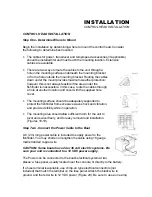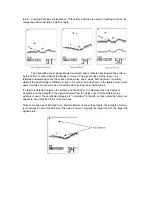
the bracket tabs (see illustration). The bracket may be broken at several points. Shorten the
bracket one tab at a time until it fits. Do not over tighten the wing nuts as this may cause damage
to the unit.
NOTE: Do not apply thread locking compounds to the unit or bracket as this may cause damage
to the unit.
Connect the transducer and power cables to the back of the LCR W.
TESTING THE INSTALLATION
After installing your LCR W unit and transducer, you are ready to test the installation.
Testing should be performed on the water, since that is the best way to confirm your transducer's
performance.
With your boat in the water, press POWER once to turn the unit on. If you press and hold
the POWER button, the simulator will be enabled. To power the unit for normal operation, press
and release the POWER button. Notice that when any button is pressed there is an audible
"chirp" that confirms the button press.
Momentarily, information will begin to "march" across the screen from right to left.
Remember that as each column advances on the screen, it contains information gathered from
several transmit and receive cycles. The column of information on the far right side of the screen
is the most current information, or the view directly under your boat. If your boat is moving, an
accurate depiction of the terrain you have just covered is created on-screen.
Increase your boat speed to ensure that the transducer remains in contact with
turbulence-free water at higher boat speeds. All Humminbird depthsounders are designed to work
at speeds of 70 MPH or more, however, use caution when operating any boat at high speed.
(High-speed testing does not apply to portable or trolling motor mounted transducers)
If the LCR W fails to locate the bottom and advance information across the screen as
shown, ensure first that the depth of the water is not in excess of the unit's capability. Also,
ensure that the unit the cable connections are correct. (The label on the cable connector matches
the label on the back of the unit).
If no audible "chirp" is heard when pressing the POWER button, the power cable or the
fuse terminal may be the problem. If the unit obviously powers up, but no bottom information is
seen on the display, the transducer is most likely the problem.
If the LCR W unit operates well at idle or slow speeds, but loses the bottom or displays
erroneous readings at higher speeds, the transducer is losing intimate contact with the water at
high speed. If your transducer is transom mounted, adjusting the running angle and depth of the
transducer may solve the problem. Several test runs and transducer adjustments may be
necessary to optimize transducer performance.























